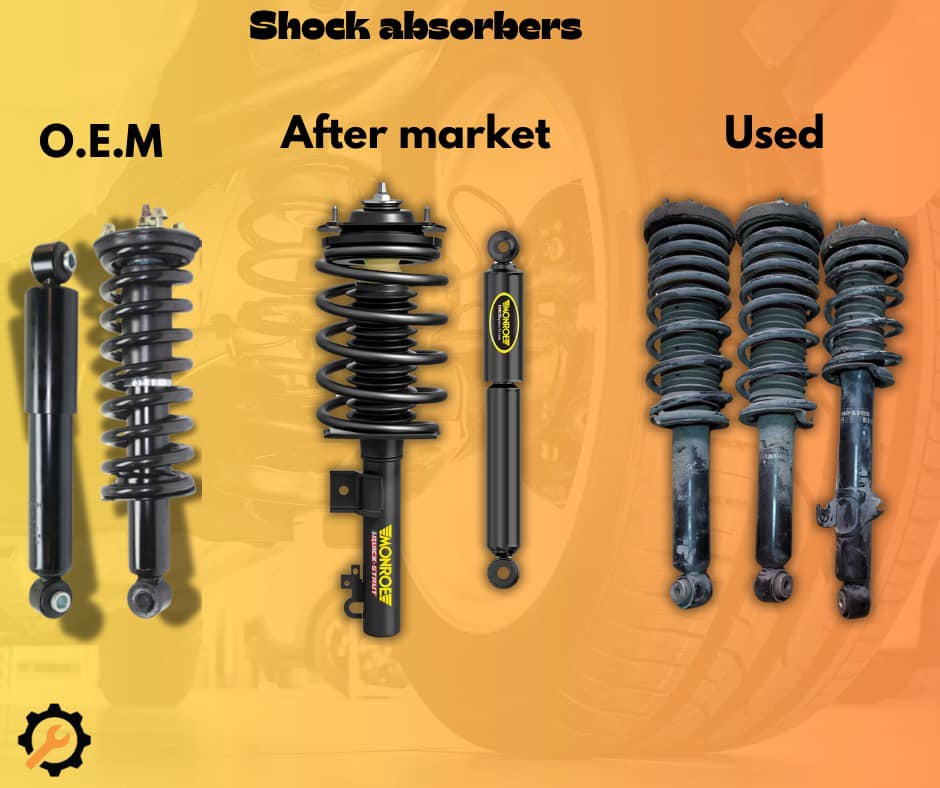OEM vs Aftermarket Vs Used Parts;
25-Jul-2024

Original equipment manufacturer (OEM) parts
Original Equipment Manufacturer (OEM) parts are auto components produced by the same company that manufactured the vehicle. These parts are designed and engineered to match the specifications and quality standards the vehicle manufacturer sets. OEM parts are often considered the highest quality, as they are designed to fit seamlessly into the vehicle’s systems and maintain its original performance and appearance.
Advantages of OEM parts:
Quality assurance: OEM parts are manufactured to precise specifications, ensuring they meet strict quality standards.
Perfect fit: These parts are designed to fit exactly as the original components, contributing to the vehicle’s safety and performance.
Warranty coverage: Many OEM parts come with a warranty from the vehicle manufacturer, providing added peace of mind.
Disadvantages of OEM parts:
Higher cost: OEM parts are generally more expensive than aftermarket or used parts.
Limited availability: Depending on the manufacturer, some OEM parts may only be available through authorized dealers.
Aftermarket parts
Aftermarket parts are auto components produced by independent manufacturers not affiliated with the vehicle’s original manufacturer. These parts are designed to replicate or improve upon OEM specifications. Aftermarket parts can vary widely in quality, features, and price, as there is a broad range of manufacturers in the aftermarket industry.
Advantages of aftermarket parts:
Affordability: Aftermarket parts are often more cost-effective than OEM parts, making them an option for budget-conscious consumers.
Variety: The aftermarket industry offers a wide range of options, allowing consumers to choose parts that suit their preferences and needs.
Innovation: Some aftermarket parts offer improved features or performance enhancements unavailable in OEM parts.
Disadvantages of Aftermarket Parts:
Quality variability: The quality of aftermarket parts can vary significantly depending on the manufacturer.
Fit and compatibility: While many aftermarket parts are designed to be compatible, there may be imperfect fit or compatibility issues.
Used and refurbished parts
Used and refurbished auto parts, also known as recycled or salvaged parts, encompass components previously installed in vehicles. These parts are removed for various reasons, such as accidents, vehicle upgrades, or replacements. While used parts refer to components that are still functional and can be reinstalled without significant modifications, refurbished parts undergo a process of restoration and renewal before being offered for sale.
Advantages of used and refurbished parts:
Cost savings: Used and refurbished parts are generally more affordable than new OEM or aftermarket parts.
Environmentally friendly: Reusing auto parts reduces the demand for new manufacturing, contributing to sustainability efforts.
Availability: Used and refurbished parts can be valuable resources for rare or discontinued components.
Quality improvement: Refurbished parts undergo meticulous inspection, repair, and restoration, often resulting in improved quality compared to their initial used state.
Disadvantages of used and refurbished parts:
Limited warranty: Used parts may come with limited or no warranty, and their longevity can vary depending on their previous usage. Refurbished parts might offer improved warranty coverage due to the restoration process.
Condition variation: The condition and history of used parts can be uncertain, leading to potential reliability concerns. Refurbished parts address some of these concerns by undergoing a restoration process.
Sourcing challenges: Finding the right used or refurbished part that fits the specific make and model can sometimes be challenging.
The auto parts industry offers consumers a variety of options to choose from, each with its advantages and disadvantages. OEM parts provide a premium, factory-fitted option, aftermarket parts offer flexibility and cost savings, and used parts provide an environmentally friendly and budget-conscious alternative. Ultimately, the choice of auto parts depends on budget, vehicle type, intended use, and personal preferences.OEM vs Aftermarket Vs Used Parts;
Used and refurbished parts
Used and refurbished auto parts, also known as recycled or salvaged parts, encompass components previously installed in vehicles. These parts are removed for various reasons, such as accidents, vehicle upgrades, or replacements. While used parts refer to components that are still functional and can be reinstalled without significant modifications, refurbished parts undergo a process of restoration and renewal before being offered for sale.
Advantages of used and refurbished parts:
Cost savings: Used and refurbished parts are generally more affordable than new OEM or aftermarket parts.
Environmentally friendly: Reusing auto parts reduces the demand for new manufacturing, contributing to sustainability efforts.
Availability: Used and refurbished parts can be valuable resources for rare or discontinued components.
Quality improvement: Refurbished parts undergo meticulous inspection, repair, and restoration, often resulting in improved quality compared to their initial used state.
Disadvantages of used and refurbished parts:
Limited warranty: Used parts may come with limited or no warranty, and their longevity can vary depending on their previous usage. Refurbished parts might offer improved warranty coverage due to the restoration process.
Condition variation: The condition and history of used parts can be uncertain, leading to potential reliability concerns. Refurbished parts address some of these concerns by undergoing a restoration process.
Sourcing challenges: Finding the right used or refurbished part that fits the specific make and model can sometimes be challenging.
The auto parts industry offers consumers a variety of options to choose from, each with its advantages and disadvantages. OEM parts provide a premium, factory-fitted option, aftermarket parts offer flexibility and cost savings, and used parts provide an environmentally friendly and budget-conscious alternative. Ultimately, the choice of auto parts depends on budget, vehicle type, intended use, and personal preferences.

 Loading..
Loading..